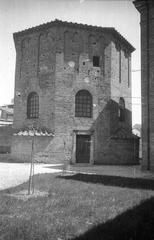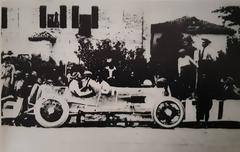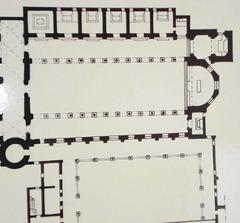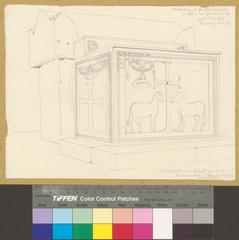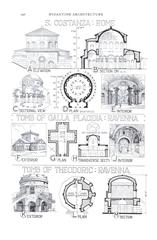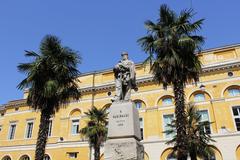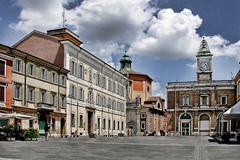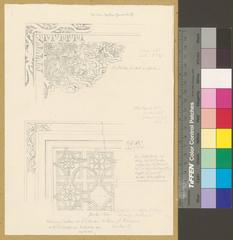Port of Ravenna Visiting Hours, Tickets, and Travel Guide
Date: 04/07/2025
Introduction to the Port of Ravenna
The Port of Ravenna, located on Italy’s Adriatic coast in Emilia-Romagna, stands as a crossroads of ancient maritime heritage and modern infrastructure. Established as early as the 6th century BCE, the port—once known as Classis—rose to prominence as a strategic naval and commercial hub of the Roman Empire and later served as the Western Roman capital under Emperor Honorius. Today, it continues to thrive as an industrial, cargo, and cruise terminal, connecting visitors to Ravenna’s rich nautical history and its renowned early Christian and Byzantine monuments, many recognized as UNESCO World Heritage Sites. (Britannica; Ancient Origins)
Travelers will find the Port of Ravenna both a gateway to the city’s celebrated mosaics and a vibrant destination in itself, offering modern amenities, cruise and ferry terminals, and sustainable energy initiatives. The port’s proximity to Ravenna’s historic center allows easy access to architectural treasures like the Basilica di San Vitale and the Mausoleum of Galla Placidia, as well as lively waterfront districts, nearby beaches, and natural parks. (Cruisability; PDWire)
This guide explores the port’s historical development, current facilities, visitor hours, ticketing, transportation, and cultural highlights—offering practical tips for planning your trip and insights into the city’s efforts to balance heritage with sustainability. (about2cruise.co.uk; Turismo Ravenna)
Table of Contents
- Discover the Port of Ravenna: History and Attractions
- Early Origins and Ancient Foundations
- Imperial Capital and Maritime Power
- Decline and Transformation in the Middle Ages
- Modern Era: Port Revival and Industrialization
- 21st-Century Modernization and Green Growth
- Visiting the Port: Hours, Tickets, and Travel Tips
- Nearby Historical Sites and Attractions
- Visitor Guide: Logistics and Facilities
- Exploring Ravenna: Sites, Experiences, and Practical Tips
- Ravenna Historical Sites: Hours, Tickets, and Attractions
- Summary and References
Discover the Port of Ravenna: A Journey Through History and Modern Attractions
Early Origins and Ancient Foundations
The roots of the Port of Ravenna stretch to the 6th century BCE, when Italic peoples settled the area. The Etruscans and Gauls occupied the region before Rome took control in 191 BCE. Ravenna’s natural lagoon harbor made it a strategic maritime hub, and by the 1st century BCE, the Roman port of Classis served as the main Adriatic naval base. Under Augustus, the port was expanded with massive quays and warehouses, supporting up to 250 ships and a naval garrison of 10,000 marines—making it among the Empire’s largest harbors. (Britannica; Roman Ports; Ancient Origins)
Imperial Capital and Maritime Power
The city’s importance rose dramatically in 402 CE, when Emperor Honorius made Ravenna the capital of the Western Roman Empire. Protected by marshes and with direct port access, Ravenna flourished as an imperial and military center. The fortified port enabled the flow of goods and grain and fostered a golden age, reflected in the city’s mosaics and monuments, many of which are now UNESCO World Heritage Sites. (Wikipedia: Classe; Turismo Ravenna)
Decline and Transformation in the Middle Ages
The decline of Rome brought neglect, silting, and repeated sackings to the port. Though Ostrogothic and Byzantine rulers restored parts of Classis, the 6th-century Lombard invasions led to its destruction and a shift of maritime power to cities like Venice and Genoa. Ravenna’s ancient port dried up, but the city remained an important administrative and cultural center. (Ancient Origins; Travel to Italy Guide)
Modern Era: Port Revival and Industrialization
In the 19th and 20th centuries, new canals and port infrastructure reconnected Ravenna to the Adriatic. The modern port at Porto Corsini and Marina di Ravenna became an industrial and commercial hub, handling bulk cargo, containers, energy products, and cruise traffic. Its strategic position supports Italian manufacturing and logistics. (PortSEurope; LinkedIn)
21st-Century Modernization and Green Growth
The “Ravenna Port Hub” project, supported by significant EU funding, is deepening canals, renovating quays, and building new terminals to accommodate larger vessels and boost cargo capacity. The port is a leader in environmental sustainability, using onshore power supplied by solar energy, advanced logistics, and digitalization—including a private 5G network to enhance safety and efficiency. (PDWire; RCR Wireless; Sustainable World Ports)
Visiting the Port of Ravenna: Hours, Tickets, and Travel Tips
- Public Access: The port is an active industrial area, but the cruise terminal and waterfront promenade are generally open to visitors from 8:00 AM to 8:00 PM. Guided tours and special events occur seasonally—check official tourism websites for schedules.
- Tickets: Purchase tickets for guided port tours and nearby historical sites online or at visitor centers. Advance booking is highly recommended during peak periods.
- Transport: Public buses, shuttles, and taxis connect the port with Ravenna’s city center (15–20 minutes). Ample parking is available for cars and tour buses.
- Accessibility: Facilities accommodate travelers with disabilities, offering ramps, elevators, and accessible shuttles.
Nearby Historical Sites and Attractions
- Basilica di San Vitale
- Mausoleum of Galla Placidia
- Neonian Baptistery
- Dante’s Tomb
- Darsena District: Contemporary waterfront with dining and nightlife
- Beaches: Marina di Ravenna, Porto Corsini, and Lido Adriano are a short drive or bus ride away.
Frequently Asked Questions (FAQ)
Q: What are the Port of Ravenna visiting hours?
A: Cruise terminal and public areas are generally open from 8:00 AM–8:00 PM. Commercial port operations run 24/7.
Q: Where can I purchase tickets for port tours and historical sites?
A: Online via official tourism portals or on-site at ticket offices.
Q: How do I travel from the port to Ravenna’s city center?
A: Shuttle buses and taxis provide quick connections; public buses are also available.
Q: Is the port accessible for those with disabilities?
A: Yes, with barrier-free paths, elevators, accessible shuttles, and assistance available.
Visitor Guide: Logistics and Facilities
Port Layout and Infrastructure
Spanning a 15-kilometer canal, the port features specialized terminals for cargo, containers, and cruise ships, with deep-water berths and modern logistics networks. (MarineLink)
Passenger and Cargo Facilities
- Cruise & Ferry Terminals: Spacious, accessible, and equipped with baggage handling, information desks, and shuttles to the city. (Cruisability)
- Commercial Facilities: Support bulk, container, and general cargo with advanced logistics and rail/road links.
Digitalization and Smart Port Initiatives
A private 5G network enables real-time tracking, automation, and safety enhancements, aligning Ravenna with European maritime innovation goals. (RCR Wireless)
Environmental Sustainability
- Shore Power: A solar-powered Onshore Power Supply (OPS) system reduces emissions from docked ships. (Sustainable World Ports)
- EcoPorts & Waste Management: Air monitoring, noise control, and rigorous waste management protocols are enforced.
Ongoing and Future Developments
Expansion of renewable energy, digital platforms, and logistics upgrades are underway, with a new LEED-certified cruise terminal set to open by 2026. (about2cruise.co.uk)
Exploring Ravenna: Sites, Experiences, and Practical Tips
Cruise Port Location and Access
Porto Corsini, 13–15 km from the historic center, is the main cruise terminal, with direct shuttles, modern facilities, and plans for an advanced eco-friendly terminal. (about2cruise.co.uk; savoringitaly.com)
Transportation Options
- Airports: Bologna (90 km), Forlì (35 km), Rimini (70 km), Venice (210 km)
- Train: Frequent connections from Bologna, Florence, and other cities
- Bus & Shuttle: Regular services link the port to city and train station; cruise lines often provide shuttles
- Car: Ample parking, well-signposted routes
- Cycling: Ravenna is bike-friendly
Parking and Luggage Services
- Parking: 1,000+ spaces at Porto Corsini, 24/7, about €20/day. Alternative city garages may offer lower rates.
- Luggage Storage: Secure facilities by the terminal let you explore luggage-free.
Terminal Facilities
- Check-in lounges, restrooms, Wi-Fi, information desks, accessible services, shops, and cafes.
Top Historical Sites and Cultural Highlights
- UNESCO Sites: Basilica di San Vitale, Mausoleum of Galla Placidia, Baptisteries, Basilica di Sant’Apollinare Nuovo/Classe, Mausoleum of Theodoric
- Dante’s Tomb: Open daily, commemorative events in September
- Darsena District: Street art, bars, urban culture
- Museums: Ravenna National Museum, NatuRa Museum
Beaches and Coastal Activities
- Marina di Ravenna: Lively beach scene, bars, and restaurants
- Porto Corsini and Lido di Classe: Family-friendly and nature-focused beaches
Local Experiences and Day Trips
- Darsenale Popup District: Trendy nightlife and street food
- Mosaic Workshops: Try the city’s ancient craft
- Po Delta Park & Pine Forests: Cycling, birdwatching, and nature
- Nearby Towns: Comacchio, Cervia, Bologna, San Marino
Sustainability Initiatives
Ravenna leads in sustainable tourism and port operations, investing in green energy, carbon capture, and eco-friendly design for new terminals. (about2cruise.co.uk)
Practical Tips
- Best Time: Spring and fall for mild weather and fewer crowds
- Booking: Secure tickets and parking in advance, especially in high season
- Accessibility: Facilities support travelers with mobility needs; check site specifics
- Language: Italian is primary, but English is common in tourist areas
Ravenna Historical Sites: Hours, Tickets, and Top Attractions
UNESCO World Heritage Sites and Historic Landmarks
Ravenna’s eight UNESCO sites are famous for their mosaics and history:
- Basilica di San Vitale: 9:00 AM – 6:00 PM, ~€10, wheelchair accessible
- Mausoleum of Galla Placidia: 9:00 AM – 6:00 PM, combined entry recommended
- Neonian & Arian Baptisteries: 9:00 AM – 6:00 PM, often included in combined tickets
- Basilica di Sant’Apollinare Nuovo/Classe: 9:00 AM – 6:00 PM, accessible by bus/taxi
- Mausoleum of Theodoric: 9:00 AM – 5:30 PM
(Full Suitcase; Emilia Romagna Turismo)
Dante’s Tomb
Open 9:00 AM – 7:00 PM, ~€5. Literary events and commemorations occur annually.
Darsena District, Piazza del Popolo, and Museums
- Darsena: Urban regeneration, bars, contemporary culture
- Piazza del Popolo: Heart of city life
- Ravenna National Museum: Tuesday–Sunday, 9:00 AM–7:00 PM, ~€8
Beaches, Nature, Outdoor Activities
- Marina di Ravenna, Lido di Dante, Punta Marina Terme: Beaches for all preferences
- Po Delta Park, Pine Forests: Nature and cycling
- Mirabilandia & Safari Ravenna: Amusement and wildlife parks
Festivals and Local Culture
- Ravenna Festival: May–July
- Mosaico di Notte: Summer nighttime monument tours
- Beaches Brew & Spiagge Soul: Summer music festivals
- Notte d’Oro: October citywide event
Gastronomy and Lifestyle
Ravenna’s cuisine features seafood, piadina, handmade pasta, and local wines. The city offers an authentic, relaxed Italian atmosphere, with a vibrant cycling culture and thriving street art scene.
Excursions & Day Trips
- Comacchio: Canals and local cuisine
- Cervia: Salt pans and hospitality
- Bologna & San Marino: Easy rail or car trips
Practical Tips
- Getting Around: Walk in the historic center, use buses/taxis/bikes for outlying sites
- Guided Tours: Available in English and other languages, highly recommended for deeper context
- Accessibility: Most major monuments are wheelchair accessible; check details for each site
Summary: Key Tips for Visiting the Port of Ravenna
The Port of Ravenna is a testament to Italy’s maritime history, offering visitors a seamless blend of ancient monuments and state-of-the-art port facilities. Cruise travelers and independent explorers alike benefit from efficient transportation, accessible infrastructure, and proximity to world-class UNESCO sites. Sustainability and digital innovation are central to the port’s operations, with green energy and smart technologies setting new standards. Planning ahead for tickets, hours, and transport ensures a smooth and enriching Ravenna experience. (Roman Ports; Ravenna Mosaics Official Website; Sustainable World Ports; RCR Wireless; Turismo Ravenna; Audiala App)
References
- Britannica: Ravenna, Italy
- Ancient Origins: Classis Ravennas
- Roman Ports: Ravenna Civitas Classis
- Turismo Ravenna: Official Tourism
- PortSEurope: Port of Ravenna
- LinkedIn: Ravenna Italy
- PDWire: Ravenna Port Modernization
- MarineLink: Port of Ravenna
- Cruisability: Destination Guide Ravenna Italy
- RCR Wireless: Vodafone Private 5G Ravenna
- Sustainable World Ports: Shore Power at the Cruise Terminal
- About2Cruise: Ravenna Cruise Ship Port Guide
- Savoring Italy: Ravenna Italy
- Full Suitcase: Ravenna Best Things to Do
- Emilia Romagna Turismo: Ravenna
- Cruise and Sea: Port Ravenna Italia
- CruiseVacationHQ: Ravenna Italy Cruise Port Guide
- FlyFreshFlight: How to Get to Ravenna Cruise Port
- The Arcadia Online: Discover Ravenna
